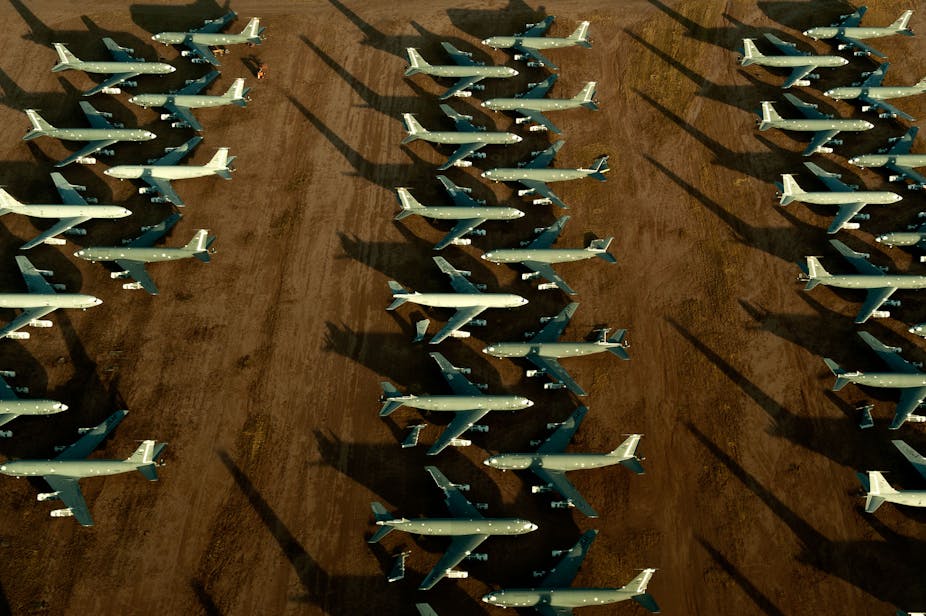Although aviation emissions contribute only 3-5% of the total impact on the planet’s climate, this is steadily growing and is a surprisingly intractable problem to solve.
As prosperity around the world increases demand for flights is rising much faster than our technical ability to curb the pollutants from aircraft engines. With many other sectors such as power generation and manufacturing having to clean up or curb their emissions, legislators are increasingly pressing the aviation industry to fall into line. In a 2011 White Paper, the European Union set a target of 60% reductions of greenhouse gas emissions from transport based on present-day levels by 2050.
Three ways to reduce the climate impact of aviation industry are commonly suggested. The first is to change the way we use the aircraft we have, by flying more efficient routes, reducing congestion, or taxiing on the ground with only a single engine. The second is to reduce demand, perhaps by offering attractive alternatives such as high-speed rail. However, this can come at significant economic cost. The third is to make use of new aircraft technologies, materials, or fuels.
There are many constraints on what technological methods can be used in an aircraft, much more so than for a road vehicle for example. The industry rightly makes safety its first priority, which means that any new technologies must be subject to rigorous testing and meet stringent certification before they can be used. Nevertheless there are technologies in development, such as open rotor engines and blended wing body aircraft, which could cut a flight’s emissions by 30% or more. This is a substantial gain in an industry where an emissions reduction of a few percent is considered a major achievement.
But the problem is exacerbated by the long lives of aircraft. A typical airliner may remain in service for 30 years or more before being replaced by a newer model. Factor in the time to develop, test and manufacture new aircraft technologies, and the time from initial concept to widespread use can be many years. This means that even significant new developments in engine and airframe technology take a long time to enter widespread use, which means the emissions of current aircraft fleets are far higher than they would be if equipped with newer models.
In fact, according to our research in a new paper published in Transport Policy, global aviation emissions could be cut by 10% just by upgrading all fleets to newer models, and this saving could be increased if those technologies and aircraft designs still under development could be used. While this is neither practical nor feasible, speeding up the aircraft replacement cycle could help reduce emissions and meet climate targets.
The challenge of phasing out older, high-emissions technology is not unique to aviation. Many governments have employed scrappage schemes in which drivers of older vehicles are paid an incentive to scrap their old and dirty car or van and buy a new, cleaner replacement. Could a similar scheme work for aviation?
To find out, we used a computer model of the global aviation system, AIM, which simulates the interaction of passenger behaviour, airport capacity, airline routing and scheduling, policy and emissions. We assumed the scrappage scheme would be funded within the industry through a carbon tax, which would provide a further incentive to reduce emissions, and examined what impact it could have up to 2050.
Our model suggests that with a scrappage scheme emissions would be about 30% lower by 2050 than without, brought about by a combination of wider adoption of cutting edge technology, fewer old aircraft in the fleet, and higher fares putting people off travelling. That’s better than nothing, but is it enough? It misses the EU’s goal of a 60% reduction for transport emissions. In fact, emissions from aviation in 2050 are higher than present-day levels, just lower than they would have been without the policy. This, and the political and financial cost of implementing such a scheme suggests that it’s unlikely to happen.
So how can we tackle this problem? The EU targets are ambitious, and opinion is divided over whether they should be binding or only aspirational. Dramatic changes will be needed in the aviation industry for its emissions in 2050 to be lower than at present. This will mean changes in attitudes to flying, unforeseen technological breakthroughs, or punitive taxes.
In the absence of these, an approach that aims for small improvements in many different aspects (flight routing, maintenance, flight load, fewer flights each carrying more passengers, alternative fuels…) is likely to be the most successful. Even then the airline industry may miss its targets, which would mean greater reductions in other forms of transport to meet the shortfall.

